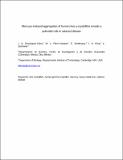Mercury-induced aggregation of human lens γ-crystallins reveals a potential role in cataract disease
Author(s)
Domínguez-Calva, J. A; Pérez-Vázquez, M. L; Serebryany, E.; King, J. A; Quintanar, L.
Download775_2018_1607_ReferencePDF.pdf (2.307Mb)
Publisher Policy
Publisher Policy
Article is made available in accordance with the publisher's policy and may be subject to US copyright law. Please refer to the publisher's site for terms of use.
Terms of use
Metadata
Show full item recordAbstract
Abstract
Cataract disease results from non-amyloid aggregation of eye lens proteins and is the leading cause of blindness in the world. A variety of studies have implicated both essential and xenobiotic metals as potential etiological agents in cataract disease. Essential metal ions, such as copper and zinc, are known to induce the aggregation in vitro of human γD crystallin, one of the more abundant γ-crystallins in the core of the lens. In this study, we expand the investigation of metal–crystallin interactions to heavy metal ions, such as divalent lead, cadmium and mercury. The impact of these metal ions in the non-amyloid aggregation, protein folding and thermal stability of three homologous human lens γ-crystallins has been evaluated using turbidity assays, electron microscopy, electronic absorption and circular dichroism spectroscopies. Our results show that Hg(II) ions can induce the non-amyloid aggregation of human γC and γS crystallins, but not γD crystallin. The mechanism of Hg-induced aggregation involves direct metal–protein interactions, loss of thermal stability, partial unfolding of the N-terminal domain of these proteins, and formation of disulfide-bridged dimers. Putative Hg(II) binding sites in γ-crystallins involved in metal-induced aggregation are discussed. This study reveals that mercury ions can induce the aggregation of human lens proteins, uncovering a potential role of this heavy metal ion in the bioinorganic chemistry of cataract disease.
Date issued
2018-08-30Department
Massachusetts Institute of Technology. Department of BiologyPublisher
Springer Berlin Heidelberg